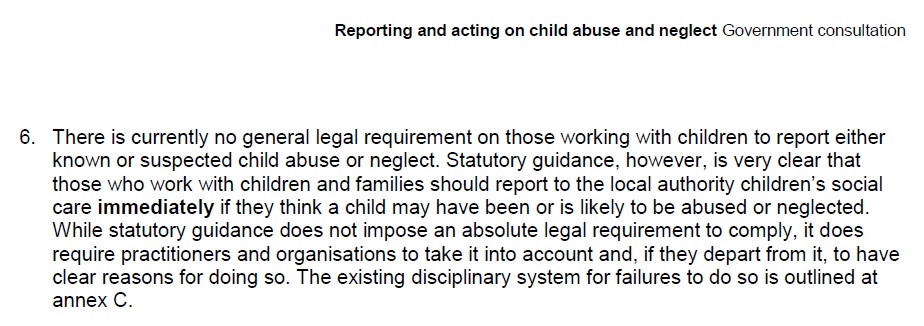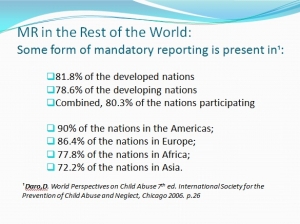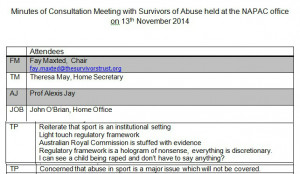On Wednesday 1st March Ian Herbert, Chief Sports Writer for the Independent, under the banner ‘Football is not rife with child abusers, so it is time for the Offside Trust to explain what they are for,’ writes a eulogy to the FA’s current child protection framework. Is it right to do so? We examine his claims and the foundations on which they are grounded.
The piece informs us:
Football is not “rife with child abusers”
and that:
“Serial criminals look for the next target, the next opportunity, such as the abuse of children for the purposes of producing internet images.”
The underlying message of the piece – it’s all different now. The claim is heard repeatedly from the Football Association.
Here’s the message again, this time from Sue Ravenlaw – Head of Equality and Safeguarding for the FA.
Where is the empirical evidence and data to support Mr Herbert’s claims? Or is it just feeling or worse still, just echoing FA executives who are motivated to convince anyone who will listen ‘it’s safe to leave your child with us?’ The FA after all, is dependent on a conveyor belt of children to become tomorrow’s professional players.
Reading Ian Herbert’s piece prompted an overwhelming sense of déjà vu. Had I heard something like this before – well meaning but misguided enthusiasm to promote the ‘it’s all different now’ narrative learned perhaps the previous day from the very organisation which failed to protect children in the past, and perhaps even the present?
Ah yes, the Child Abuse in Football debate, House of Lords on 15/12/16 and the opening speech by Lord Goddard. He is the descant to Ian Herbert’s cantoris in the chorus :
Lord Goddard was good enough to at least say he had spoken the previous day to James MacDougall of the FA who apprised him of the glowing child protection situation that today makes it ‘one of the safest industries for young boys and girls to go into.’ Goodness, that’s a claim and a half. But it’s incorrect because the FA is only doing what’s expected of all Regulated Activities by the so called, but dysfunctional, ‘statutory guidance.’
Mr MacDougall is not himself directly involved in child protection, he is the Senior Public Affairs Manager for the Football Association.
Like Lord Goddard’s well-meaning speech, Mr Herbert’s article is ‘all veneer no wood.’ It’s an unevidenced gushathon in support of FA child protection. But he hasn’t bothered lifting the lid on the complex subject of child protection in these even more complex settings. He says:
“There is a need for clarity because football in 2017 is not rife with child abusers. The FA – maligned though it so very often is – has been diligent in its work to safeguard children and the game’s adolescent men and women. The moral panic which accompanies revelations like last autumn’s militate against calm analysis but an examination of English sport’s work in the field of child protection reveals it to be more thorough than that of any nation in the world.”
Child Protection in sport [Sports are defined as Regulated Activities by the Safeguarding Vulnerable Groups Act 2006] can have little reliance placed upon it but then neither can child protection in any other Regulated Activity. Most child protection ‘experts’ are unaware how the statutory framework and statutory guidance fails them and their well intentioned objective of protecting children. The co-author of a leading legal reference book on child protection law in common law jurisdictions wrote to me in 2009 saying:
“To start with it is important to recognise two problems in the current law relating to child abuse:
- It is a patchwork of different types of law often created as a specific reaction to a particular scandal. It has no cohesion and can be contradictory. It is, for want of a better description, the Dangerous Dogs Act writ large.
- It is unwieldy. There are hundreds of different rules in different places.”
This is the dysfunctional foundation on which the child protection cards stands. It cannot be relied on.
I included this statement into a Powerpoint slide when I presented to the leadership team at the PFA on the 9th January 17. My opening statement was :
“I am going to tell you what very few people can or will tell you about the dysfunctional child protection framework that undermines the ability of well intentioned personnel in Regulated Activities to deliver child protection on which reliance can be placed.”
My presentation shared a number of similarities to my meeting with Secretary of State for Education Michael Gove in February 2014. Surprisingly the Department of Education has Child protection in its remit. Quite why is anyone’s guess, its done a spectacularly poor job of it and is crippled with inertia. To my surprise the meeting found its way into the Times newspaper some weeks later.
For both the PFA and Mr Gove I produced detailed empirical evidence to support my assertions. Not to have done would have resulted in me being ushered to the door with a “bonkers” label pinned to my lapel.
Mr Herbert’s article continues:
“His conviction (Paul Hickson Swimming coach) triggered the creation, in 2002, by Sport England and the NSPCC in 2002, by Sport England and the NSPCC of the government-backed Child Protection in Sport Unit (CPSU) – the first dedicated national office and resource centre of its kind in the world.
Within a few years, the FA and other governing bodies had child protection policies in place, including criminal checks of new recruits by the former Criminal Records Bureau, now called the Disclosure and Barring Service, and a designated member of staff responsible for child welfare at each club. Any sport in breach of these rules would be refused Sport England funding.”
Mr Herbert seems unaware that Child Protection policies are unsupported by the existence of law requiring and supporting members of staff in Regulated Activities to report known or suspected abuse on reasonable grounds. The first time the Government committed this to paper for public consumption was 21/7/16 in the consultation document below.

Taken from the Consultation – ‘Reporting and Acting on Child Abuse and Neglect’ – launched on the last day of Parliament (21.07.16) with Government presumably hoping no one would notice. The date coincides with the largest Regulated Activity, education, starting its holidays with most of the country.
In the above slide – MR is Mandatory Reporting.
Mr Herbert refers to two shiny badges – the CPSU and Sport England.
The CPSU is unable to get even simple foundation facts about child protection correct. This is a press release from Mandate Now on 15/12/16 which coincided with the House of Lords debate titled : Confused Football Association safeguarding policy fails children.
The CPSU endorsed the FA’s grassroots child protection policy that was wrong legally and also muddled. But the NSPCC, of which the CPSU is part, has been getting the law wrong repeatedly and misadvising ‘professionals’ perhaps because the NSPCC is so ill-disposed to controvert the Government on such core issues. During the debate which we fully reported upon here, Baroness Brinton said:
Disclosure and barring was also mentioned in Mr Herbert’s article but he seems oblivious to the dramatic changes to it that occurred in the Protection of Freedoms Act 2012. From being a quango that showed signs of promise but in need of improvement, to a component of child protection that is hanging by a fingernail. This is all available on our website in a recent post titled – Alternative Perspective on NSPCC – Closing the Loopholes in Sport – VictoriaLIVE 26.1.17 .
Given Mr Herbert is Chief Sports Writer for the Independent, it is disappointing he is unaware that Baronesses Heyhoe Flint and Grey Thompson were very much to the fore in speaking against the proposed changes and the impact they would have on child protection in sport.
As for Sport England, here is an Article which quotes Phil Smith (Director of Sport) who adopts the it’s all different now groupthink theme that once again is absent of any data or supporting evidence for his opinion. His contribution was a triumph of hope over reality. We challenged him on Twitter, but he didn’t hang around long and then threw himself into the clutches of the NSPCC which unsurprisingly supports of the Government’s intended outcome of the consultation which is ‘Duty to Act.’ We unstitched Duty to Act in our submission. In short, it’s the failing status quo with a counterfeit label applied. We suggested it was designed to fail for which it has an unguided motive – cash.
Mr Herbert continues:
“But one experienced former welfare officer at a major club told me: “The FA was on to the problem and the infrastructure for protection has been very substantial for a long time.”
So confident is the former welfare officer in his/her opinion that s/he remains anonymous. And of course he/she is talking groupthink. Does s/he know their legal position if they report suspected abuse (you rarely see actual abuse)? I bet not. The reality is they have no protection from legal action other than the Rizla paper provided by the Public Interest Disclosure Act – good luck.
The combination of all these shortcomings leads to ‘gaze aversion’ which is one of the most significant reasons for not reporting abuse, It is cited repeatedly in data replete empirical research from Australia and the USA.
‘It’s all different now’ does not bear scrutiny. Without mandatory reporting law, child protection is entirely dependent on value judgements. Other issues that were similarly dependent on such judgements included smoking, drink driving and seat-belts. Law was finally introduced whereupon culture changed arrived.
Until mandatory reporting is introduced to Regulated Activities, with data capture pre and post MR, no claims of UK child protection effectiveness are credible. Here is our review of such research from the single jurisdiction of Western Australia
Mr Herbert continues:
“Many senior detectives say the same. “Serial criminals look for the next target, the next opportunity, such as the abuse of children for the purposes of producing internet images,” said one. “We need to be pursuing the next target, not the last one.”
Again, we are being asked to rely on the anonymous claims of ‘senior’ police officers for this absurd assertion. It would be astounding if the alleged officers were in Child Abuse Investigation Units, but quite understandable if assigned to burglary and car crime. And perhaps rather than speaking to the police, it might have been more helpful had Mr Herbert spoken to a Local Authority Designated Officer (LADO). They deal specifically with alleged adult on child abuse in Regulated Activities. Furthermore, research from the Royal Commission into Institutional Responses to Child Sexual Abuse in Australia evidences that Regulated Activities can be Petri dishes for (repeated) child abuse. This is because the settings are target rich environments which provide perpetrators with (legitimate) contact and the holy trinity for abusers – power, opportunity, and secrecy. This is one of the reasons all states in Australia (and the USA – e.g. Sandusky, Penn State where MR law has just been strengthened) have introduced Mandatory Reporting into most of these settings.
“Brackenridge was commissioned to lead the FA’s Child Protection in Football Research Project from 2000….. “
The article omits to say is that Professor Brackenridge’s work was truncated thanks to aggressive financial cuts which coincided with the building of the new stadium. That said, Professor Brackenridge’s report did not mention the absence of the aforementioned critically important law to report. This she, and others learned at a child protection in Sport conference at Brunel in early 2009 when I raised the matter after a presentation by a member of the CPSU. A number of the attendees were understandably shocked. I took with me counsel’s opinion which I’d received in late 2008. A number of the attendees spoke with me in the break, keen to read the opinion. But understandably, relatively few appreciated the precarious position the news put child protection in sport (and other Regulated Activities) into.
No – things are not all different now but they need to be. To make them different law must be introduced. We explain here and even provide draft legislation. We are out of step with the rest of the world.
It’s time the well-intended safeguarders at the FA realised the child protection framework on which their policies are grounded fails all the safeguarding personnel, the children in their care, and their parents.
By Tom Perry
P.S
Child abuse in sport has been a long running issue. I know about this subject, I was abused in a sporting context within a school. It’s a matter of record. And so, when I was invited to meet the Home Secretary with a small group of abusees to discuss the CSA inquiry crisis following the resignation of the second Chair Fiona Woolf, I suggested sport needed to addressed by the inquiry. Below is the redacted minute:
Please note the question mark appended to one of my comments. I was making a statement – the note taker could not quite believe it and so put in a question mark. Many child protection personnel are still ignorant of the facts thanks to the opaque Statutory Guidance that defeats most. The framework has the features of having been designed to fail. Why might this be so?



